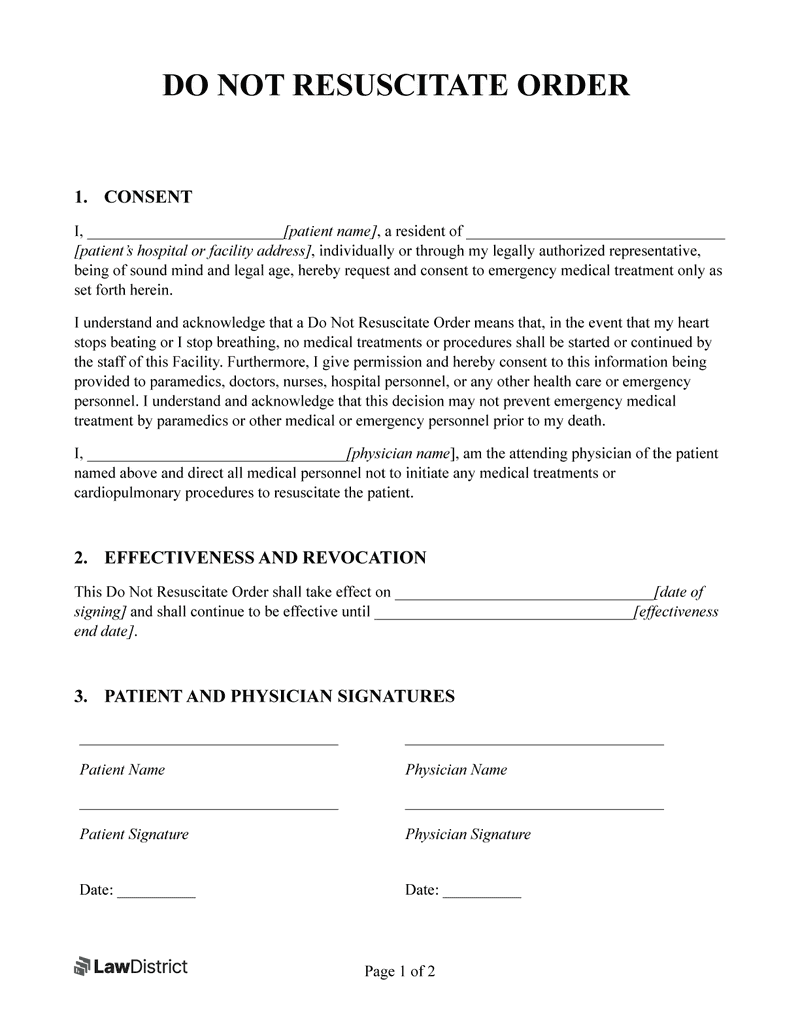OUT OF HOSPITAL DO NOT RESUSCITATE ORDER
FOR
_________
ATTENTION! DO NOT MAKE ANY ATTEMPT TO RESUSCITATE THIS PATIENT!
This document represents the official request, legal in the State of Alabama, to order all medical personnel to cease any attempt to resuscitate the Patient and allow a natural death.
If you live in a state with a prehospital DNR program, it is important that you use your state's approved procedure and document. Any other document may not be honored.
A. Patient Request:
I, _________, the undersigned Patient, am competent and at least 18 years of age. I direct that resuscitative measures be withheld from me in the event of cardiopulmonary cessation. Specifically, I direct that none of the following resuscitation measures be initiated or continued for me: Cardiopulmonary resuscitation (CPR), transcutaneous cardiac pacing, defibrillation, advanced airway management, and artificial ventilation.
I have discussed this decision with my physician, and I understand the consequences of this decision.
Patient's Signature:
By: ___________________________________ Date: __________________
_________
B. Physician Authorization:
Based on the information provided, I/we direct all medical personnel, emergency responders, and paramedical personnel to refrain from performing resuscitative measures, including cardiopulmonary resuscitation, chest compression, endotracheal intubation, advanced airway management, artificial ventilation, cardiac resuscitative medications, and cardiac defibrillation, if the Patient experiences cardiopulmonary cessation.
In addition, we request that all reasonable comfort care measures be implemented, including the administration of oxygen, suction, control of bleeding, and pain medication by authorized personnel. Our goal is to alleviate the Patient's suffering and provide support to their family members, friends, and anyone else present.
Physician's Signature:
By: ___________________________________ Date: __________________
______________________________________
(print name)
County of ____________________
State of Alabama
I ____________________________, a Notary Public in and for said County and State, hereby certify that ___________________________________, whose name(s) is/are signed to the foregoing instrument, and who is/are known to me (or satisfactorily proven), acknowledged before me on this day that, being informed of the contents of the instrument, she/he/they executed the same voluntarily on the day the same bears date. Given under my hand this ________ day of ________________, ________.
__________________________(Notary Public Signature)
Notary Public
My commission expires: __________________________
C. Applicability of a prehospital DNR Program:
In some states with official prehospital Do Not Resuscitate (DNR) programs, healthy individuals may not have access to these programs because they are often limited to those diagnosed with a terminal illness.
This approach stems from the fact that there are emergencies where healthy individuals may require immediate medical intervention, including CPR, without suffering long-lasting adverse effects. For example, otherwise healthy individuals may experience allergic reactions, electrical shocks, choking incidents, or cardiac arrests resulting from heart attacks, but often make a full recovery after receiving prompt emergency treatment. These situations differ from resuscitating individuals in the advanced stages of a terminal illness. Therefore, it is widely believed that prehospital DNR programs are more suitable for preventing unwanted emergency measures that prolong the dying process or increase suffering rather than applying them to healthy individuals.
However, regardless of health status or age, individuals generally retain the right to consent to or refuse medical treatment. If you hold strong beliefs about specific medical procedures, including prehospital emergency treatment, please consult with your physician or attorney. Additionally, we recommend completing a Living Will, Health Care Power of Attorney, or Health Care Advance Directive to officially document your wishes.
